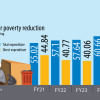Poverty Reduction: Bangladesh makes significant stride

Bangladesh got about 19.3 million people out of poverty between 2004 and 2014, the fastest reduction in UNDP’s poverty index during that period.
The 2019 global Multidimensional Poverty Index (MPI), released on Thursday, said the population in multidimensional poverty in Bangladesh had dropped to 74.4 million in 2014 from 93.7 million in 2004.
This year, the index covered 101 countries -- 31 low income, 68 middle income, and 2 high income. It covered 5.2 billion out of 5.7 billion people in those countries.
The index used 10 indicators -- nutrition, child mortality, years of schooling, school attendance, cooking fuel, sanitation, drinking water, electricity, housing, and assets -- to determine different dimensions of poverty.
Across the studied countries, 1.3 billion people or 23.1 percent are multidimensionally poor. Two-thirds of them live in middle-income countries, the report said.
This year’s spotlight on child poverty in South Asia revealed considerable diversity, it said. Half of the poor are children under 18 and a third are under 10.
The report analysed 10 countries with a combined population of about 2 billion to illustrate different patterns of reduction in MPI values. It covered every developing region and spanned three income categories: upper middle (Peru), lower middle (Bangladesh, Cambodia, India, Nigeria, Pakistan, and Vietnam), and low (Democratic Republic of the Congo, Ethiopia, and Haiti).
The 10 countries made overall progress towards Sustainable Development Goal-1: No Poverty.
Eight countries saw a significant reduction in their MPI values and a combined drop in the number of poor people from 1.1 billion to 782 million.
“The fastest absolute reductions in MPI value were in Bangladesh, India, and Cambodia, followed by Ethiopia and Haiti,” the report said.
Ethiopia, India, and Peru significantly reduced deprivations in all 10 indicators, each in different ways.
Ethiopia made improvements in nutrition, school attendance, drinking water, and assets. India strongly improved assets, cooking fuel, sanitation, and nutrition. And Peru developed clean energy, electricity, housing, and assets.
Bangladesh and Cambodia reduced deprivations in nine indicators, Haiti reduced deprivations in eight and Democratic Republic of the Congo and Pakistan reduced deprivations in six indicators.
“In all 10 countries, rural areas are poorer than urban areas,” it said. In Bangladesh and Democratic Republic of the Congo poverty fell at the same speed in rural and urban areas, it added.
“To fight poverty, one needs to know where the poor people live. They are not evenly spread across a country, not even within a household,” said UNDP Administrator Achim Steiner.
Child poverty fell faster than adult poverty in Bangladesh, Cambodia, Haiti, India and Peru. But children fell further behind in Ethiopia, and their progress -- together with that of adults -- stalled in Democratic Republic of the Congo and Pakistan, the report said.
The MPI was developed in 2010 by the Oxford Poverty and Human Development Initiative at the University of Oxford and the Human Development Report Office of the UNDP for the flagship human development report.

 For all latest news, follow The Daily Star's Google News channel.
For all latest news, follow The Daily Star's Google News channel. 







Comments